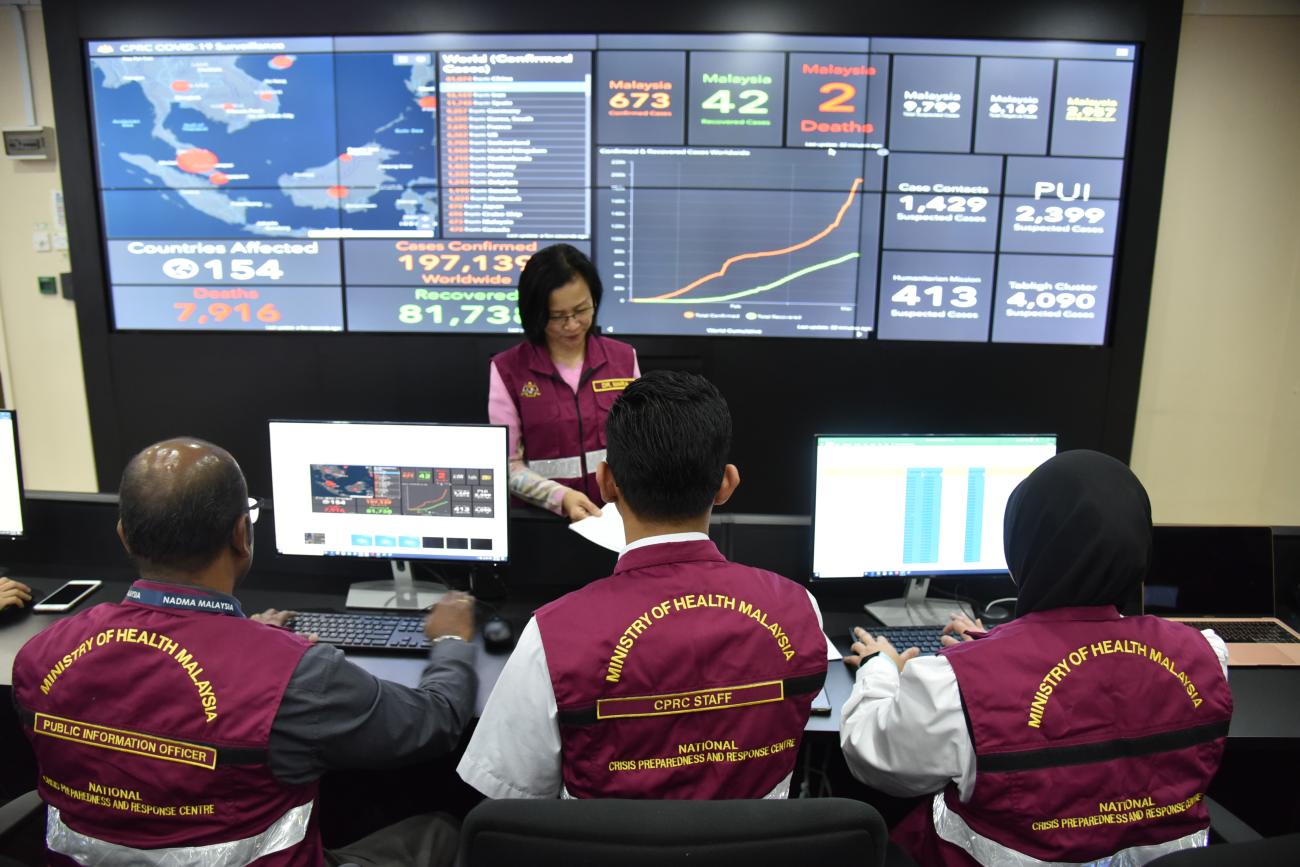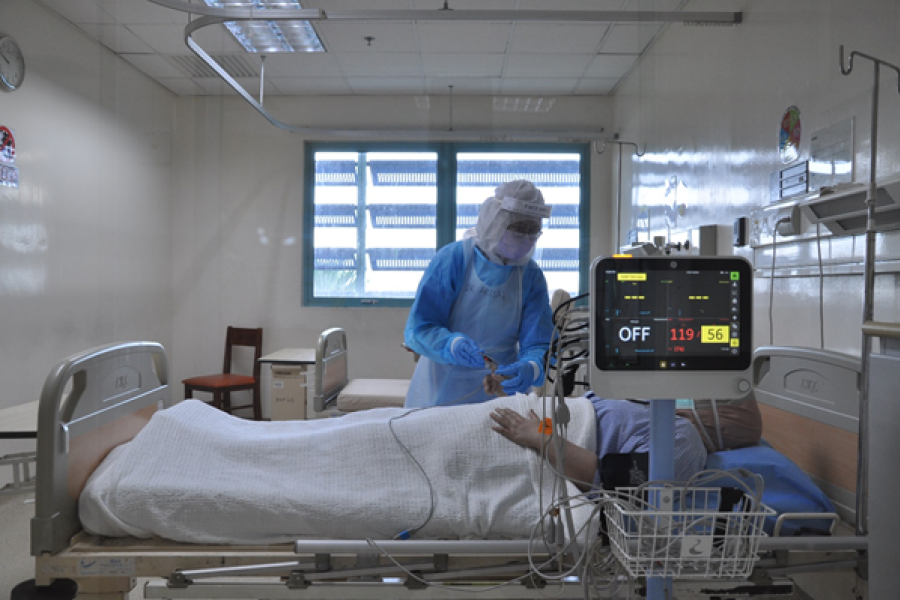A country united in the face of the pandemic

Malaysia enforced the “Search, Test, Isolate, Treat and Quarantine” strategy to uncover cases in the community.
Malaysia has strong capacity in outbreak preparedness and response, as well as the infrastructure and a well-trained workforce to provide high-quality health care. These have helped establish a stable foundation for the outbreak response to COVID-19 so far. In the years prior to the pandemic, the government and the health authorities took great steps to bolster Malaysia’s health security and multisectoral response capacity for health emergencies and disaster preparedness. These measures included preparation for and participation in a Joint External Evaluation of the International Health Regulations core capacities with the World Health Organization (WHO) in late 2019 to help identify the most critical gaps within human and animal health systems and the containment of environmental hazards. Identification of gaps enabled the prioritization of needs and opportunities for enhanced preparedness and response. All of these components have played a crucial role in Malaysia’s initial response to the pandemic.
In the early stages of the outbreak, in February 2020, Malaysia invested in increasing access to quality testing, the number of critical care beds and available ventilators. Health services were swiftly enhanced to meet both anticipated and emerging demands, as the government operationalized the Crisis Preparedness and Response Centre (CPRC) at the national and state levels, and mobilized for recruitment and redistribution of health-care personnel according to high workload areas.
Malaysia also took immediate steps to curtail transmission of the virus, including the implementation of the Movement Control Order and its various phases and iterations, which succeeded in helping reduce the number of COVID-19 cases by half over the month of April. Following key WHO recommendations to “test, treat and track” the population for the virus, Malaysia enforced the “Search, Test, Isolate, Treat and Quarantine” strategy to uncover cases in the community. It also took stringent measures regarding quarantine and isolation of confirmed and suspected cases.
Significant measures were taken to communicate with the public proactively. The Malaysian government went to great lengths to ensure a comprehensive approach to risk communication and community engagement and working to establish trust with the population. From the early days, the government promoted trusted sources of information to ensure the public had access to timely and accurate information on the latest COVID-19 developments and to offset the risk of an infodemic, as well as focusing on mass media campaigns and media monitoring. They leveraged technology, and social media platforms and mobile applications became a powerful channel for outreach when paired with creative content and strategic messaging. To reach and appeal to the culturally diverse population in Malaysia, the government used as many channels of communication as possible to reach the greatest number of people.
All of these conditions and actions paved the way for a decisive and coordinated initial national emergency response, with the full support of WHO and partners for a whole-of-government and whole-of-society approach.

WHO support
WHO Representative Office for Malaysia, Brunei Darussalam and Singapore works closely with the Ministry of Health and partners to provide critical support in the areas of partner coordination, information and planning, technical expertise, operational support and logistics. For example, WHO supplied initial test kits before they became commercially available and provided testing protocols for diagnosis during March 2020. Moreover, Malaysia was invited to join WHO’s solidarity treatment study, becoming the first country in Asia to enrol patients. All support was supplemented by regional and global strategies and best practices, with WHO working as part of the United Nations Country Team in supporting a consolidated UN response to COVID-19 in Malaysia.
WHO country office has participated in strategic discussions with national health authorities, partners and stakeholders and supported other key activities, including the implementation of non-pharmaceutical interventions, through frequent development of informational, educational and communication materials. A strategic platform was developed for all COVID-19 response-related activities, which include procurement, surveillance and monitoring, epidemiology, and data collection, processing and analysis, to provide for evidence-based information and policy advice.
WHO also supports the efforts of the Ministry of Health to visualize and determine a longer-term goal for the response and sustainability, providing guidance to facilitate the planning, implementation and evaluation of activities. The use of mathematical models to simulate the transmission dynamics of the virus in Malaysia helped to project scenarios of future transmission based on expected changes in the implementation of non-pharmaceutical interventions. These projections allowed the modellers to anticipate requirements for the nation’s health system, such as hospitals and ICU beds, should there be a resurgence of infections.
While working to mitigate the spread of COVID-19, Malaysia was also responding to a poliovirus outbreak that was confirmed in December 2019. It was the country’s first outbreak since being declared polio-free in 1992. Immunization campaigns had to be temporarily halted or delayed to manage the initial burden imposed on the health system by COVID-19. The Global Outbreak Response Task Team donated 2.5 million doses of polio vaccine to Malaysia for supplementary immunization campaigns. WHO, UNICEF and other partners worked in collaboration with the Ministry of Health to control the outbreak, through enhanced surveillance, case detection, risk communication and the resumption of the immunization response. The country was one of the first to resume its immunization campaigns.
Way forward
National efforts should continue to encourage people to maintain their recommended precautionary practices. Ongoing vigilance and prevention are our only ways to stop virus transmission until a safe and effective vaccine is available. These measures have been successful at containing and limiting transmission of COVID-19 so far, but the country is seeing another surge in cases. As cases begin to rise again and the situation continues to evolve, the government is considering the reintroduction of public health measures, such as restriction of movement and travel, to prevent further transmission and potentially exceeding the capacity of the health system.
Malaysia should continue to reinforce surveillance systems to detect the presence and circulation of COVID-19, as well as other infectious diseases, such as poliovirus and influenza. Health facilities have implemented strong infection, prevention and control measures and non-pharmaceutical interventions, and the Ministry of Health has begun mobilizing staff to reinforce front-line health workers for possible future resurgences.

With societies reopening, schools resuming and people going back to work and travelling, coupled with caution fatigue, cases are rising among young people, resulting in a higher risk of transmission and spread among their age group and onward to family members and higher-risk, vulnerable populations. Emphasis should be put on promoting the role of youth in protecting others and reducing transmission, as well as the continued caution and adherence to preventative measures by the entire population, no matter the occupation or age. This includes ensuring measures are implemented in closed settings like prisons and detention centres.
Malaysia needs to build on its success to date by adopting a long-term approach. This includes being prepared to respond to any new clusters with targeted, localized measures. COVID-19 has demonstrated how interlinked health and the economy are. By using a targeted response approach combined with individual behavioural interventions, economic disruption can be minimized while keeping the epidemic under control.
WHO and its partners will continue their work on developing safe and effective COVID-19 treatments and vaccines, as well as coordinating the equal distribution and deployment of these options worldwide once available. Moving forward in this response, it is critical that everyone – from stakeholders and decision-makers to the general public – continue doing their part in a collective and unified manner. This is the key to a successful and sustainable national response to COVID-19, as no one is safe until everyone is safe.



